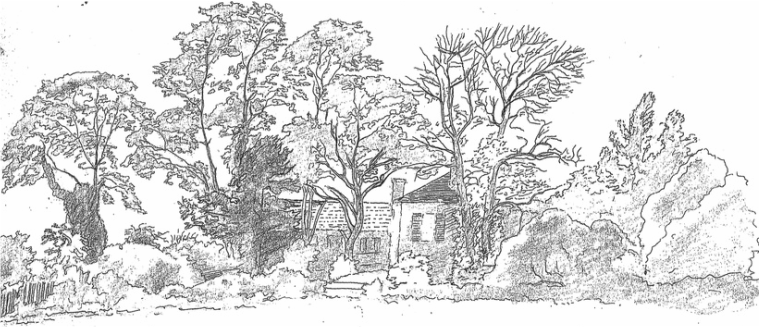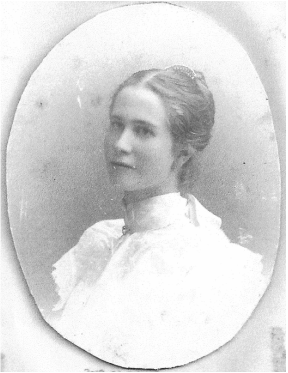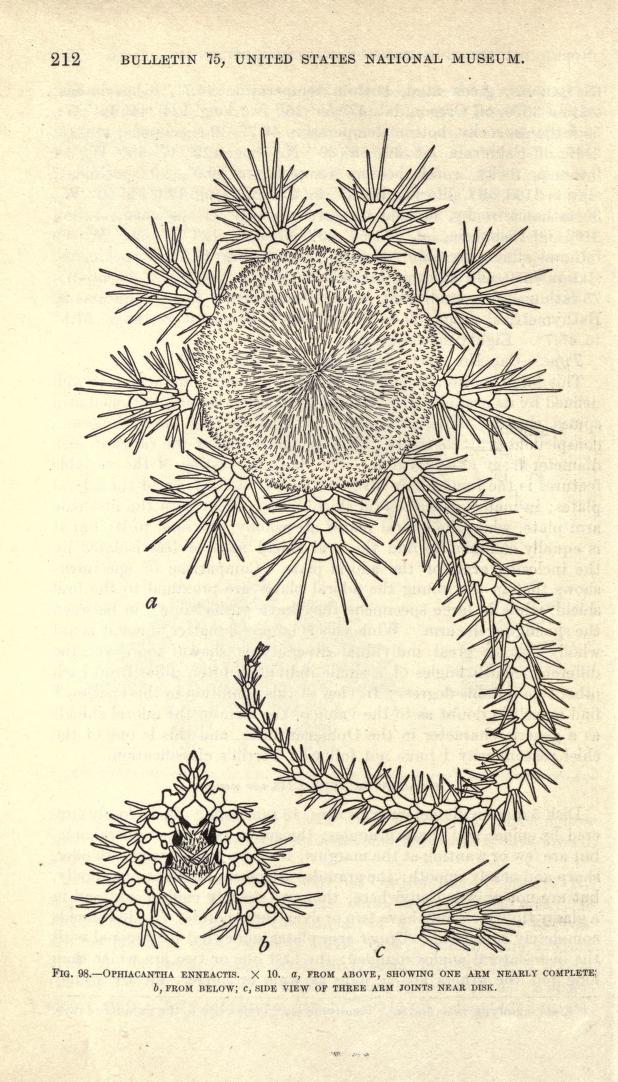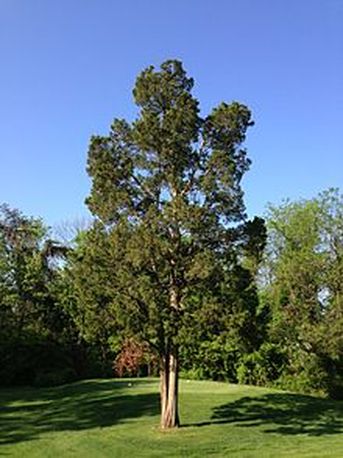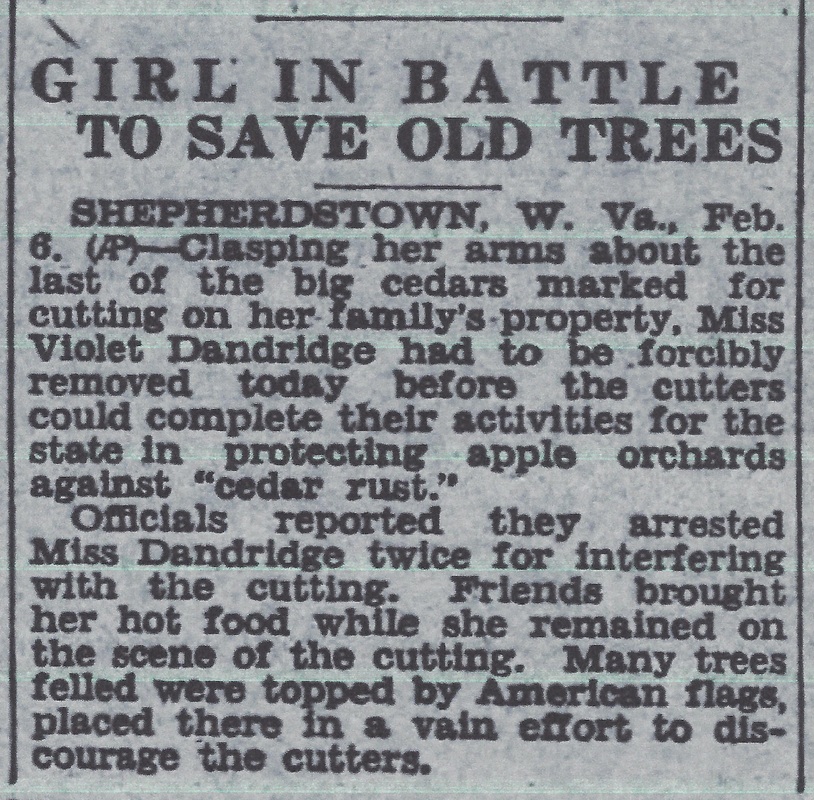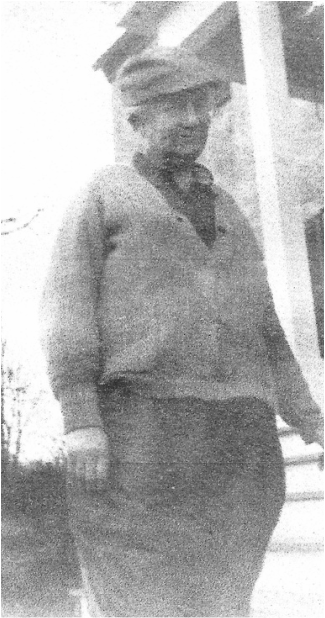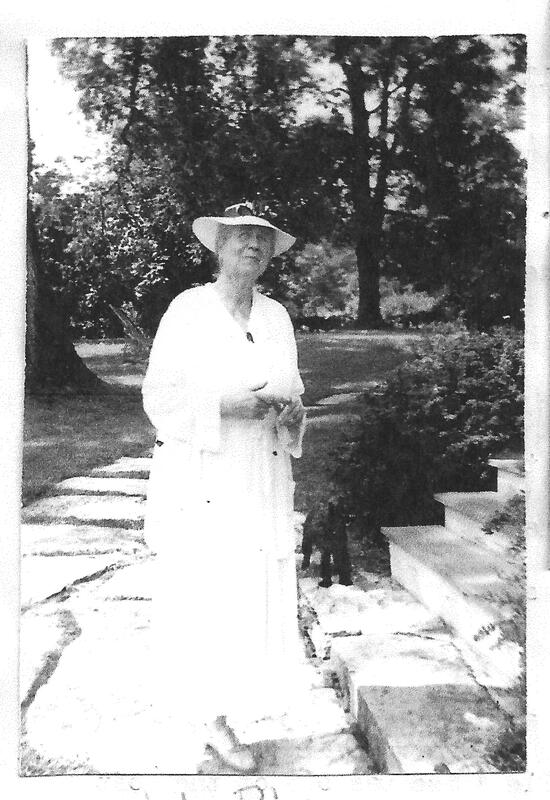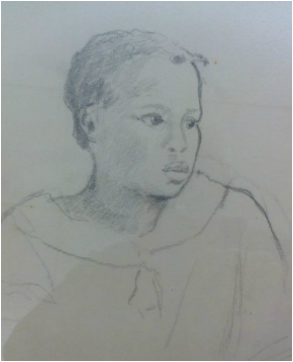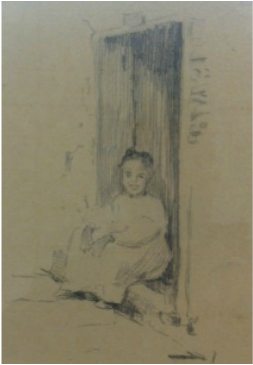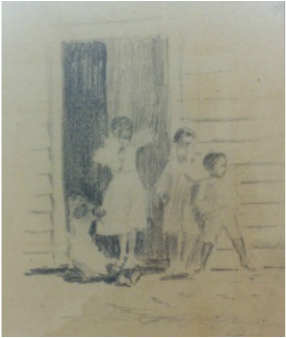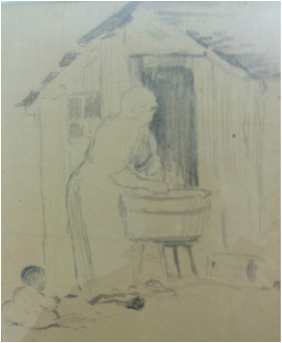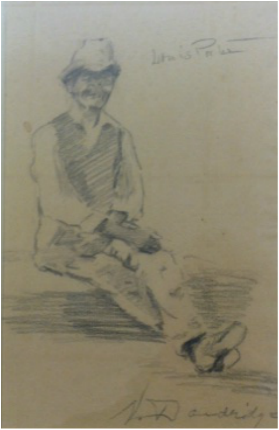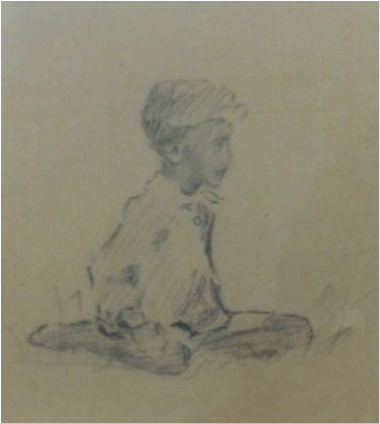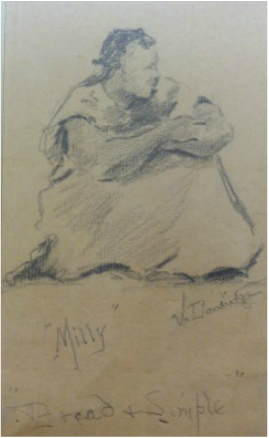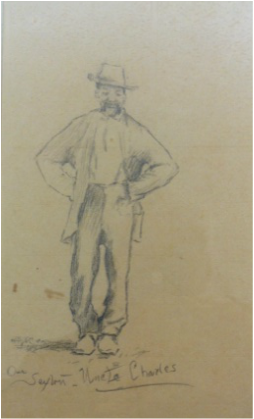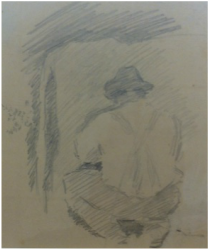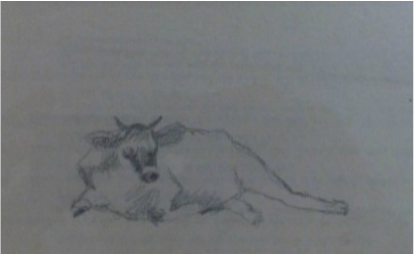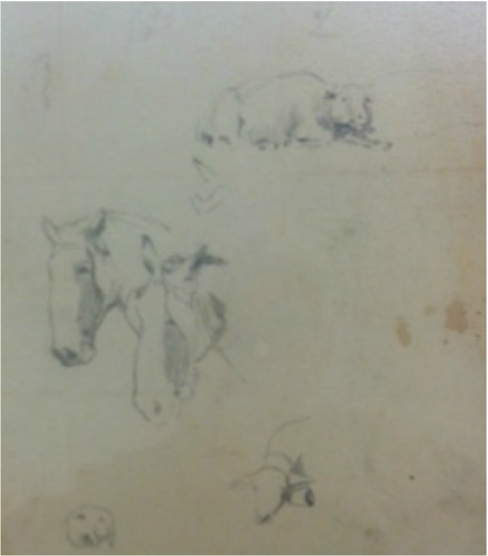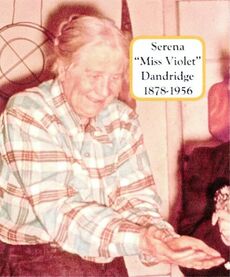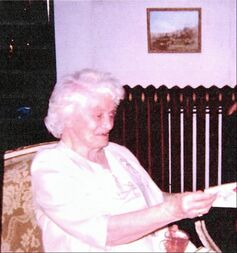Serena Katherine (Miss Violet) Dandridge (356)
|
Serena Katherine Dandridge was born 15 March 1878 at "The Bower" in Jefferson County, West Virginia. Her mother was Caroline Dane (Danske Dandridge) Bedinger, the renowned poet, and author of historical and nature articles. Her father was Adam Steven Dandridge III of "The Bower", the ancestral mansion of the Dandridge family on the Opequon River in Jefferson County. Adam Stephen Dandridge was a merchant of Shepherdstown and representative in the West Virginia legislature. Serena's grandfather was Hon. Henry Bedinger (1812-1858), U. S. Representative and Ambassador to Denmark and her great grandfather was Daniel Bedinger (1861-1818). Serena, or Miss Violet as she was commonly called, was an artist of great ability and expressed her love and devotion to nature, her religion and friends in her many poems, writings and art. She held a deep respect and interest in nature,
|
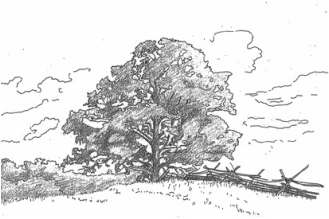
plant and animal. She expressed and held a benevolent kindness and love of children, especially the underprivileged Afro-American children of Shepherdstown who would accompany her on her rounds in the town. Known as "Miss Violet", she raised sheep and in her later years inherited a farm near Shepherdstown from her aunt and namesake, Serena Katherine Dandridge. On the farm she raised Guernsey cattle and delivered milk to families in Shepherdstown. Even though a gentle and soft spoken lady, she did not leave the work of her sheep raising and dairying to men. She dressed in jodhpurs, man's riding pants, and sweaters for her work and is remembered for having driven her cattle down German Street in Shepherdstown.[i]
In about 1896 Serena was living in Washington, D. C., and met the family of Frank Sewall (1837-1915), theologian and pastor of he Swedenborgian or New Church in that city.[ii] The Swedenborgian Church, or the New Christian Church, understands the Bible in the light of the theological writings of Emanuel Swedenborg. which affirms freedom of choice and following life’s path experiencing both good and evil. Swedenborgians profess to step from stone to stone in life, each member choosing the truth, feeding the good in their lives, loving the good in all people, and acknowledging the living spirit that enlightens their experience. Serena's conviction of belief in the tenets of the Swedenbordian Church, though made at the formative age of eighteen, were maintained through her life as evidenced by her leaving a bequest to the Church in her will.
Through the Sewalls, she met Howard Helmick (1845-1907) and began the study of art under his direction. Following a hiatus in her art career related to an illness, Violet returned to Washington and in 1903 began to draw various specimens for scientific publication of the National Museum in the Smithsonian Institution. Here she met Dr. Hubert Lyman Clark (1870-1947) of the Museum of Zoology at University. She went to Cambridge and Woods Hole, Maine for short periods of collection and study of marine animals.[iii]
Through the Sewalls, she met Howard Helmick (1845-1907) and began the study of art under his direction. Following a hiatus in her art career related to an illness, Violet returned to Washington and in 1903 began to draw various specimens for scientific publication of the National Museum in the Smithsonian Institution. Here she met Dr. Hubert Lyman Clark (1870-1947) of the Museum of Zoology at University. She went to Cambridge and Woods Hole, Maine for short periods of collection and study of marine animals.[iii]
|
While employed at the National Museum, Miss Violet Dandridge made hundreds of drawings of marine creatures that were published scientific journals. She was praised for her patience, skill and the accuracy of the drawings. Above, is Lycodes jordani of Alaska,[iv] on the right is an ophiuran (brittlestar), Ophiacantha enneactis, from the north Pacific,[v].
While working as an artist at the National Museum, Violet was known for her excellent depiction in ink drawings of biological specimens for scientific publications. She was sought to draw specimens by several biologists including Herbert Lyman Clark, Mary Rathbun, Edmund Goldsborough, and Austin Hobart Clark. The scientists often praised her art work and her interest in the subjects of her drawings, as did Austin Hobart Clark [vi], who wrote, "For the illustrations of this report I was fortunate as to be able to secure the services of Miss Violet Dandridge of Shepherdstown, West Virginia, U. S. A., who is herself an enthusiastic and earnest student of the echinoderms."
At times, Miss Violet also accompanied scientists in their collecting expeditions. In 1911 Miss Violet and Miss Rathbun collected 1,000 specimens in Main and in August, at marine sites, including Woods Hole, Massachusetts collected specimens and made color notes to be used in reproducing the natural colors on the prepared material. Miss Violet applied her skill to the innovative incorporation of painting many of the specimens in their natural colors.[vii]
|
|
Miss Violet shared her mother's love for horticulture and held an intense interest in the gardens at Rosebrake that were started by her grandmother, Caroline Bowne Lawrence Bedinger. The gardens were enhanced and cultivated by her mother Danske Dandridge, an activity that formed the basis for her mother's numerous articles on gardening that appeared in publications.
|
When Serena was about 20 years of age she composed and mailed a Valentine poem to her parents in Charlotte, West Virginia where her mother, Danske, was convalescing from an illness. [viii]
A Valentine by Serena Katherine Dandridge
|
The Battle to Save the Red Cedar Trees
|
Miss Violet's battle to save the venerable old cedar trees in the Shepherdstown area was widely reported in newspapers of the day and drew the attention of many sympathetic to her cause, citing historical and legal issues. Supporters of her cause in the Shepherdstown area promptly organized a league to defend the rights of local property owners and elected Miss Violet as Secretary of the organization. Her actions brought the criticism from apple growers and government officials. The Governor of West Virginia complained that the display of the American flag was an attempt to intimidate law enforcement officers. The notice above is from the Reading (Pennsylvania) Times, 7 February 1930. The"girl" of the headline, Miss Violet, was 36 years of age a the time.
|
A lady of independent thinking and firm conviction, Miss Violet was known to stand up for her beliefs against overwhelming odds. When the eastern red cedar trees in the Shepherdstown area were determined to be the source of rust infection in the area apple trees, the State initiated a campaign to eliminate the cedar trees within the range of three miles of each commercial orchard.
Miss Violet , in leading the anti-cutting group, had many in the town who came to her aid, including Harry L. Snyder, editor of the Shepherdstown newspaper, the Register, Susan Lemen,whose 500 trees were being cut and H. L. Snyder, Jr., an attorney and the son of the cedar-crusading editor of the Register. An account of the incident is given in Katherine Scarborough's In Defense of Beauty (1931) in which Miss Scarborough describes the beauty of the trees in the landscape and points out that the cedars harbored birds that consumed insects harmful to the apple crop. In addition, Maryland, within a stone's through of Shepherdstown across the Potomac River, had no cedar cutting law and thus cutting the cedars in Shepherdstown did little good to save the local West Virginia apple trees. Serena K. Dandridge, Miss Lemen's agent and H. L. Snyder, Jr. obtained an injunction for the cessation of cutting until an appeal could be could be taken. The West Virginia Supreme Court denied her appeal and the State cedar cutting crews went back to work. Miss Dandridge confiscated the tools of the cutters and attached American flags to the cedar trees. She was arrested twice for interfering with the axmen. She was released after her first arrest and a justice of the peace dismissed her case following the second arrest. It was reported that finally in the early twilight of the winter afternoon Miss Dandridge's embrace was loosened, her fingers were unlaced, her arms unclasped from about the tree, and she was moved to safety. The State's woodsmen were only slightly delayed by by the protests of Serena Dandridge. The situation was thus resolved by enforcement of the law, but her action was typical of the adamant nature of her convictions. She won many friends by her stand even though it was a lost cause.[ix], [x], [xi], [xii] |
The Death of a Tree
By Serena Katherine Dandridge[xiii]
By Serena Katherine Dandridge[xiii]
|
In early morn she fell
When all the other trees Awoke in the glad breeze. She shivered in her Summer And all the birds flew from her. The Norway pine, he caught her Ah, tragedy was here. A moment straight and fine She stood though, cleaved asunder Then groaned and fell with thunder. How much too large she lies For any grave of earth, Hushed is the woodman’s mirth For here in death so vernal He feels the touch eternal. |
Then do they hack and mar
What died so perfectly Her highest leaf they see And up and down with pleasure They stretch on her their measure. O’ when the woodsman’s gone and night looks down on her Her leaves awaken and stir The weight of birds she misses The stars and heavens kisses And to the sleeping rabbit And to the earth-minded mouse Who build in her a house To all that creeps unknowing Her silent tears are flowing. |
|
Violet raised sheep and in her later years inherited from her aunt a farm near the "Bower" on the Opequon River where she raised sheep and Guernsey cattle. Even though a gentle and soft spoken lady, she did not leave the work of her sheep raising and dairying to men. To many she was eccentric. She dressed in mannish clothing, wearing long pants before many women were seen publicly in slacks. She worked in the fields with men and is remembered for having driven her cattle down German Street in Shepherdstown. After milking the cows she sold the milk and drove around town with colored men and boys delivering milk. In the early 1950's, packs of dogs were attacking the sheep in Jefferson and Berkeley County. The counties passed laws which called for licensing of dogs and apprehension of those caught marauding sheep, but the law was not being enforced in Berkeley County. Most sheep herders were reluctant to insist the law be enforced, but Miss Dandridge, then up in years, mounted a movement among sheep-herders to have the law enforced. Miss Dandridge was quoted in the newspapers saying that shepherding is not only a business for her but on principle is close to her heart and it tore her soul to see sheep and lambs killed by dogs. She personally lived close to the sheep especially during lambing season, watching for dogs.[xiv]
|
Serena Katherinbe Dandridge dressed for church
Although known generally as "Serena" or "Miss Violet", to many of her friends she was also known as "Old Pie" or "Pie" for she was the Pied Piper for dozens of children and was one of he most beloved and unforgettable characters they would ever know. For years she had a class of Afro-American children every Sunday after the "white Sunday school" in the Episcopal chapel back of the church. On Sunday afternoons the Shepherdstown children flocked to Rosebrake to spend time in the barn or in the fields with Pie, chasing her ponies, watching at birds or listening to her tales about their habits.
Serena produced a series of twenty five pencil sketches, entitled "A Shepherdstown Sketchbook". The subjects included the people she knew, children she loved and befriended, the boys who helped her deliver milk, the children in her Sunday school class, and their mothers and fathers. Not to be left out were the animals she kept, her cows, sheep and draft horses with the men who tended them. These remarkable sketches reveal an insight into her kind nature and her fond memories of her town.[xv]
Serena produced a series of twenty five pencil sketches, entitled "A Shepherdstown Sketchbook". The subjects included the people she knew, children she loved and befriended, the boys who helped her deliver milk, the children in her Sunday school class, and their mothers and fathers. Not to be left out were the animals she kept, her cows, sheep and draft horses with the men who tended them. These remarkable sketches reveal an insight into her kind nature and her fond memories of her town.[xv]
|
Miss Violet's first cousin Nina Cornelia Mitchell came to live at Rosebrake after Serena's father died in 1923. Nina and Serena shared ownership of Rosebrake having inherited the estate from their grandmother Caroline Bowne Lawrence, the wife of Henry Bedinger (45). Both Nina and Serena were lovable and beneficent, but they were as different as two people could be. Nina inherited affluence and could be quirky but also lavish in her generosity to friends. Serena was without great wealth from her parents and relied on her dairy and sheep raising for income. She was outgoing, giving, genuinely loving person with untold friends and admirers. Nina and Serena did not enjoy a happy relationship. Days often went by when they did not see each other. Nina was very comfortably financially and would occasionally spend time abroad. Serena during lambing season would sometimes spend a month alone at her property on the Opequon River.[xvi]
|
Serena had several spells of illness and had sought treatment and convalescence at the Sheppard Pratt and other hospitals. When her mother died in 1914, she was away from home being treated. Serena Katherine Dandridge died November 7, 1956 at the Sheppard Pratt Hospital in Baltimore where she had gone for treatment.[xvii]
Sources:
[i] Family files, Historic Shepherdstown Museum, Historic Shepherdstown Commission, Shepherdstown, West Virginia.
[ii] Bedinger and Dandridge Family Papers, David M. Rubenstein Rare Book & Manuscript Library, Duke University, Durham, North Carolina.
[iii] Bedinger and Dandridge Family Papers, David M. Rubenstein Rare Book & Manuscript Library, Duke University, Durham, North Carolina.
[iV] Evermann, Barton Warren and Goldsborough, Edmund Lee, 1907, The Fishes of Alaska, Bureau of Fisheries Document No. 624, 360 p.
“The ...ink drawing... of …Lycodes jordani by Miss Violet Dandridge.”
[V] Clark, Hubert Lyman, 1911, North Pacific Ophiurans in the Collection of the United States National Museum, Bulletin 75, United States National Museum, 1911, 302 p.
p. 2 "And I take pleasure in acknowledging, also, with sincere gratitude, the patience and skill with which Miss Violet Dandridge has made the figures."
p. 6, "For the collaboration of an excellent artist, Miss Violet Dandridge, and for many other courtesies in the preparation and publication of this report I am indebted to the National Museum, ..."
[vi] Austin Hobart Clark, 1912, The Crinoids of the Indian Ocean, Echinoderma of the Indian Museum, Part VII. Crinoidea, Calcutta, Printed by order of the Trustees of the Indian Museum, 325 p.
[vii] Smithsonian Institution, United States National Museum, Report on Progress and Condition of the United States National Museum for the Year Ending June 30, 1912.
[viii] Family files, Historic Shepherdstown Museum, Historic Shepherdstown Commission, Shepherdstown, West Virginia.
[ix] Raleigh Register, Beckley, West Virginia, Nov. 8, 1956.
[x] The Morning Herald (Hagerstown, Maryland) Feb. 7, 1930.
[xi] Biggs, Alan R., Ph. D., Professor of Plant Pathology and extension West Virginia University, Kearneysville Tree Fruit research and Education Center, [no date given], Shepherdstown's "Battle of the Cedars", 5 p.
[xii] Fischel, William A., Professor of Economics, Dartmouth College, "the Law and Economics of Cedar-Apple Rust: State Action and Just Compensation in Miller v. Schoene", 2004, 70 p.
[xiii] Bedinger and Dandridge Family Papers, David M. Rubenstein Rare Book & Manuscript Library, Duke University, Durham, North Carolina.
[xiv] Family files, Historic Shepherdstown Museum, Historic Shepherdstown Commission, Shepherdstown, West Virginia.
[xv Archives, Scarbrough Library, Shepherd University, Shepherdstown, West Virginia
[xvi] Family files, Historic Shepherdstown Museum, Historic Shepherdstown Commission, Shepherdstown, West Virginia.
[xvii] Raleigh Register, Beckley, West Virginia, Nov. 8, 1956.
Page modified 28 March 2015 and 6 March 2019
Page modified 6 March 2020
